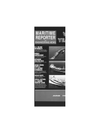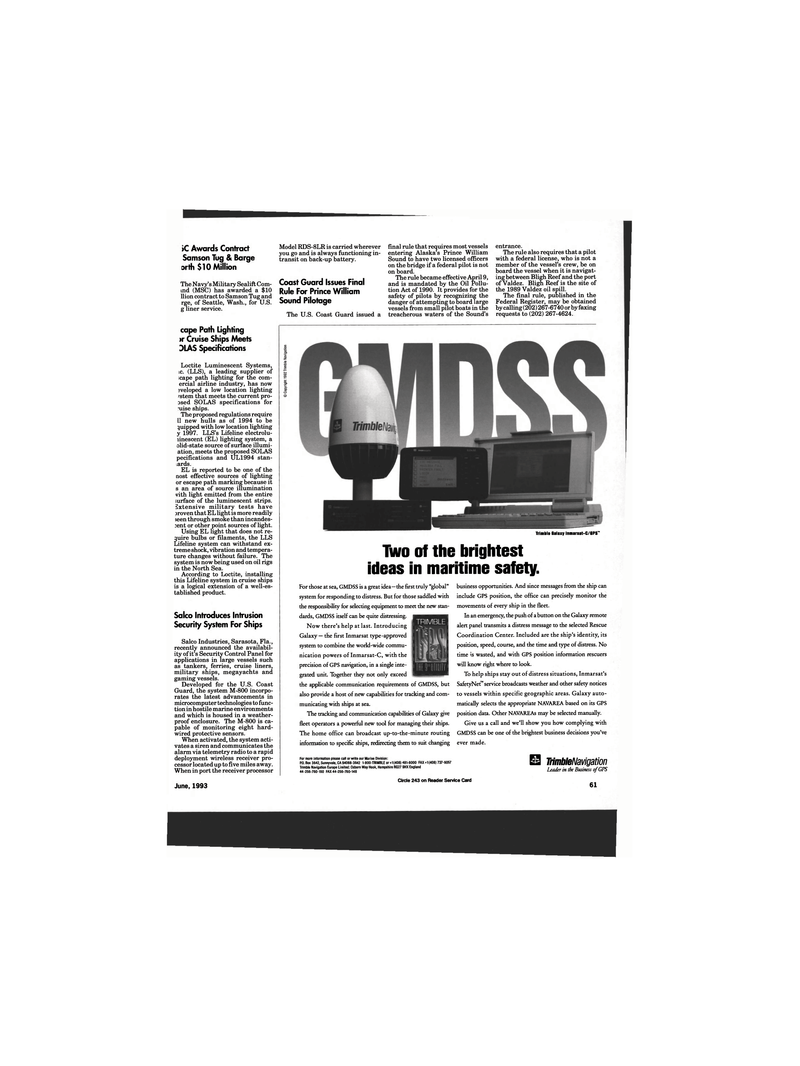
Page 60: of Maritime Reporter Magazine (June 1993)
Read this page in Pdf, Flash or Html5 edition of June 1993 Maritime Reporter Magazine
>C Awards Contract
Samson Tug & Barge orth $10 Million
The Navy's Military Sealift Com- ind (MSC) has awarded a $10 llion contract to Samson Tug and rge, of Seattle, Wash., for U.S. g liner service. cape Path Lighting >r Cruise Ships Meets
DLAS Specifications
Loctite Luminescent Systems, lc. (LLS), a leading supplier of icape path lighting for the com- ercial airline industry, has now jveloped a low location lighting rstem that meets the current pro- ased SOLAS specifications for *uise ships.
The proposed regulations require 11 new hulls as of 1994 to be quipped with low location lighting y 1997. LLS's Lifeline electrolu- linescent (EL) lighting system, a olid-state source of surface illumi- ation, meets the proposed SOLAS pecifications and UL1994 stan-
Lards.
EL is reported to be one of the nost effective sources of lighting or escape path marking because it s an area of source illumination vith light emitted from the entire surface of the luminescent strips.
Extensive military tests have aroven that EL light is more readily seen through smoke than incandes- cent or other point sources of light.
Using EL light that does not re- quire bulbs or filaments, the LLS
Lifeline system can withstand ex- treme shock, vibration and tempera- ture changes without failure. The system is now being used on oil rigs in the North Sea.
According to Loctite, installing this Lifeline system in cruise ships is a logical extension of a well-es- tablished product.
Salco Introduces Intrusion
Security System For Ships
Salco Industries, Sarasota, Fla., recently announced the availabil- ity of it's Security Control Panel for applications in large vessels such as tankers, ferries, cruise liners, military ships, megayachts and gaming vessels.
Developed for the U.S. Coast
Guard, the system M-800 incorpo- rates the latest advancements in microcomputer technologies to func- tion in hostile marine environments and which is housed in a weather- proof enclosure. The M-800 is ca- pable of monitoring eight hard- wired protective sensors.
When activated, the system acti- vates a siren and communicates the alarm via telemetry radio to a rapid deployment wireless receiver pro- cessor located up to five miles away.
When in port the receiver processor
Model RDS-8LR is carried wherever you go and is always functioning in- transit on back-up battery.
Coast Guard Issues Final
Rule For Prince William
Sound Pilotage
The U.S. Coast Guard issued a final rule that requires most vessels entering Alaska's Prince William
Sound to have two licensed officers on the bridge if a federal pilot is not on board.
The rule became effective April 9, and is mandated by the Oil Pollu- tion Act of 1990. It provides for the safety of pilots by recognizing the danger of attempting to board large vessels from small pilot boats in the treacherous waters of the Sound's entrance.
The rule also requires that a pilot with a federal license, who is not a member of the vessel's crew, be on board the vessel when it is navigat- ing between Bligh Reef and the port of Valdez. Bligh Reef is the site of the 1989 Valdez oil spill.
The final rule, published in the
Federal Register, may be obtained by calling (202) 267-6740 or by faxing requests to (202) 267-4624.
Trimble Balaxy Inmirsat-C/GPS™
Two of the brightest ideas in maritime safety.
For those at sea, GMDSS is a great idea—the first truly "global" system for responding to distress. But for those saddled with the responsibility for selecting equipment to meet the new stan- dards, GMDSS itself can be quite distressing.
Now there's help at last. Introducing
Galaxy — the first Inmarsat type-approved system to combine the world-wide commu- nication powers of Inmarsat-C, with the precision of GPS navigation, in a single inte- grated unit. Together they not only exceed the applicable communication requirements of GMDSS, but also provide a host of new capabilities for tracking and com- municating with ships at sea.
The tracking and communication capabilities of Galaxy give fleet operators a powerful new tool for managing their ships.
The home office can broadcast up-to-the-minute routing information to specific ships, redirecting them to suit changing
For more information please call or write our Marine Division:
R0. Box 3642, Sunnyvale, CA 94088-3642 1-800-TRIMBLE or +1 (408) 481-8000 FAX +1 (408) 737-6057
Trimble Navigation Europe Limited: Osborn Way Hook, Hampshire RG27 9HX England 44-256-760-150 FAX 44-256-760-148 business opportunities. And since messages from the ship can include GPS position, the office can precisely monitor the movements of every ship in the fleet.
In an emergency, the push of a button on the Galaxy remote alert panel transmits a distress message to the selected Rescue
Coordination Center. Included are the ship's identity, its position, speed, course, and the time and type of distress. No time is wasted, and with GPS position information rescuers will know right where to look.
To help ships stay out of distress situations, Inmarsat's
SafetyNet™ service broadcasts weather and other safety notices to vessels within specific geographic areas. Galaxy auto- matically selects the appropriate NAVAREA based on its GPS position data. Other NAVAREAs may be selected manually.
Give us a call and we'll show you how complying with
GMDSS can be one of the brightest business decisions you've ever made.
E3 TrimbleNavigation
Leader in the Business of GPS
June, 1993
Circle 243 on Reader Service Card 61

 59
59

 61
61
